Machine gun from the Count and Archduke
And "maxim", like lightning strikes.
"Well, well, well!" - says the gunner,
"Well, well, well!" the machine gun says.
Lyricist V. Dykhovichny
stories about weapons. It is well known that dentists, photographers and merchants also took on the creation of firearms in the XNUMXth century. Although there were many hereditary gunsmiths among its creators. But there were not so many titled among them. The reason is class and pride in belonging to a certain “caste”. It was unthinkable that in the same tsarist Russia, a representative of the military caste or an official would go to the patent office, draw plans, set up production, that is, would go down the social ladder. That is, an officer could, by order, or even at his own request, engage in the creation of new weapons, but this was regarded either as a sad necessity - “an order is an order”, or as a whim, but then this “blissful” should have been a rich man, that is “That’s how he wanted it!”
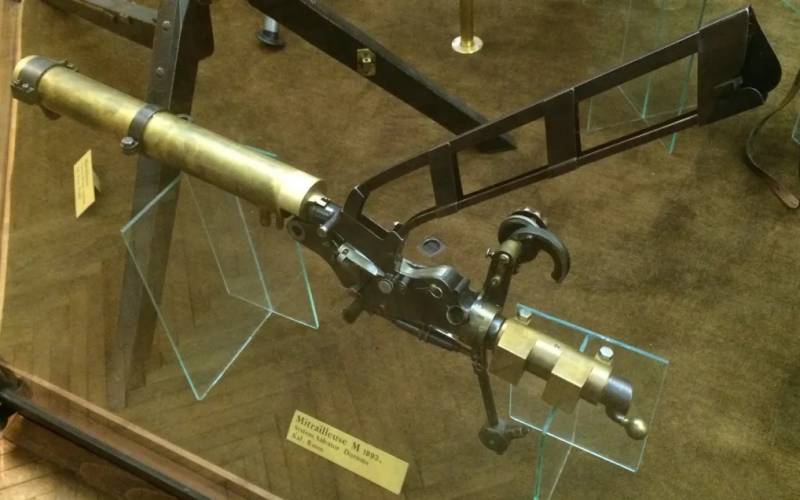
Isn't it true that the design looks very ... funny. This “machine” is not similar to any other machine gun. Museum of the military stories, Vienna. Photo forgottenweapons.com
Perhaps, the attitude towards military invention, except for Russia, was just as negative in only one European country - in Austria-Hungary, where, on the one hand, the military elite of Austria set the tone, and on the other, the cavalry and cavalrymen of Hungary, and both of them were snobbish enough. But there are no rules without exceptions, and the results of some of these "exceptions" have been very interesting. Here is one such “exception” - the 1893 Salvator-Dormus machine gun of the year, we will tell you today.
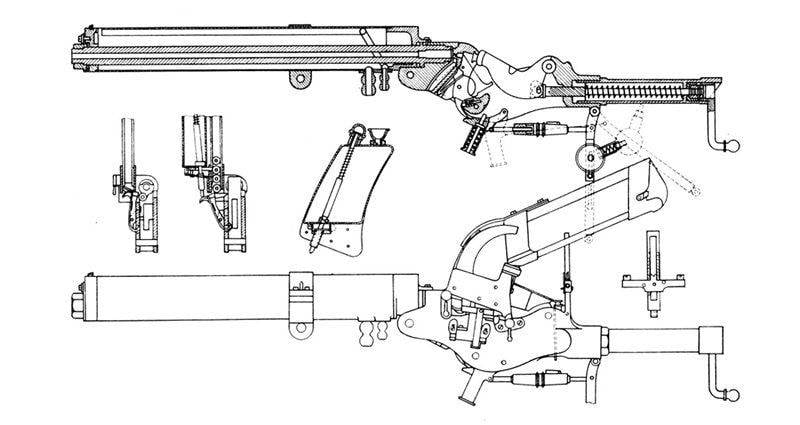
Scheme of the machine gun "Salvator-Dormus". It clearly shows the “gravity magazine” for the cartridges that were fed into the machine gun due to its own weight, and, which is especially interesting, the oiler device for lubricating the cartridges. For each such machine gun, when refueling, 3 liters of water and ... 0,5 liters of gun oil were required!
It was developed by Colonel and Count of the Austro-Hungarian Army Georg von Dormus and Archduke Karl Salvator in 1888, but they presented the finished model in 1890.
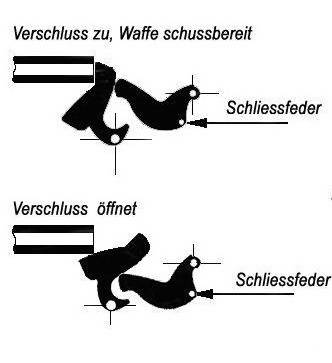
Scheme of the operation of the bolt mechanism of the machine gun. Above - the trunk is locked. Below - the trunk is open
Archduke Karl Salvator was born on April 30, 1839 in Florence, his family belonged to one of the branches of the Habsburg dynasty, but in his youth he received a military technical education, and then became interested in designing new types of weapons. As for Georg von Dormus, he was born on January 7, 1853 in the city of Olmutz in a military family. He graduated from the Military Technical Academy, and then in 1881 became a teacher at the Technical Military Academy in Mödling (Austria). Just then, the son of Karl Salvator, Leopold, also studied there, and Major Georg von Dormus became his teacher. And the son, most likely, told his father about him, and, apparently, he told it in such a way that Karl Salvator wanted to get to know him. How and where their acquaintance happened is unknown, but it happened, and as a result, these two, at first glance, very different people began to work together. Since 1884, their names appear in patents for new types of firearms, among which was the machine gun patented in 1888, which they created in defiance of the Maxim machine gun. And already in 1893, their machine gun was adopted by the army, and in 1894 and fleet Austria-Hungary as Mitrailleuse M/93. And since its mass production was carried out by the Skoda company in Pilsen, it also became known under the designation Skoda M1893.
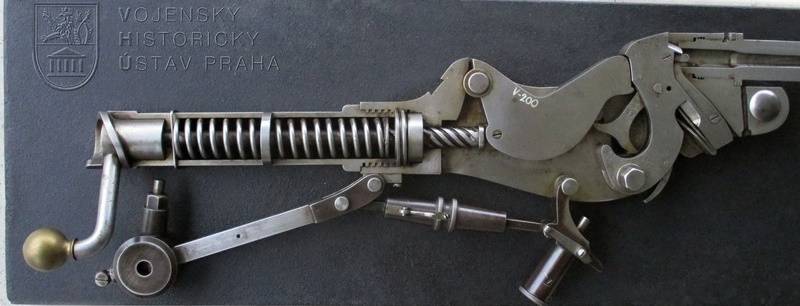
Sectional machine gun mechanism. The shutter and the lever locking it, the extractor are clearly visible, and below the pendulum lever with a load in the form of a disk (to the left of the handle). Military History Institute, Prague
The performance characteristics of the machine gun were as follows:
Weight: 20 kg including water and oil. Length: 1070 mm. Barrel length: 525 mm. Magazine capacity: 20-30 rounds. Cartridge: 8x50R. Bullet speed: 618 m/s Rate of fire: 180-300 rounds per minute. The pedestal installation for the Navy weighed 220 kg and had a 6-mm bulletproof armor shield. Sight graduation: 1600 steps.
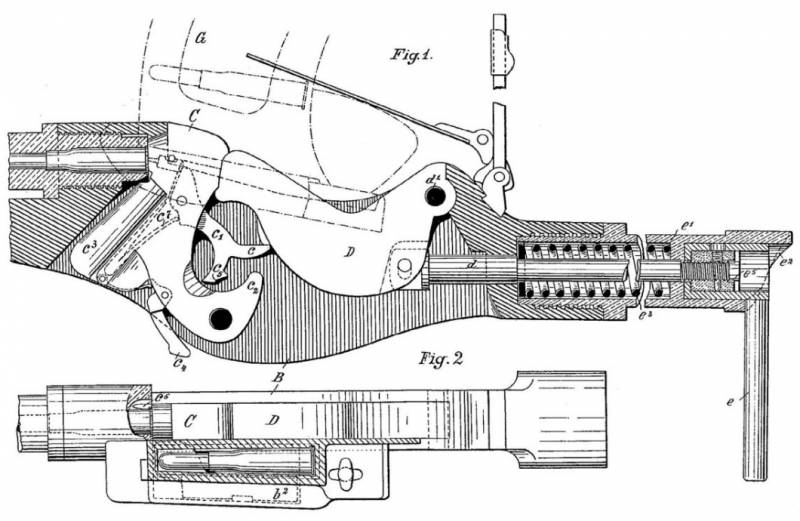
Sectional diagram of the shutter: C - shutter; D - supporting its lever; C1 - drummer lever; C7 - drummer lever spring
The first thing that catches your eye when comparing this machine gun with the Maxim machine gun is ... weight. It seems that it also has a casing for water, but the machine gun as a whole weighs 7 kg less than its "big brother". However, if we turn to its device, then the differences will be completely striking! First of all, the Maxim automatics operated due to the recoil of the moving barrel. Since the barrel passed through a tank of water, this required the presence of seals, seals, in a word, everything that takes a lot of time and effort during maintenance. On a Salvator-Dormus machine gun, the barrel would be motionless, that is, the shutter, like in many pistols, was ... free! And not just free, but also swinging! And under quite strong cartridges 8x50R.
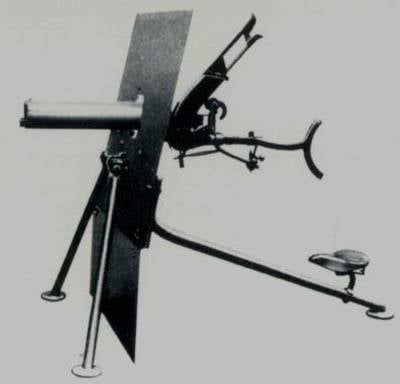
Infantry version of the M1893 machine gun on a tripod and with a shield
It is known that the shutter machine gun "Maxim" was very complex and required very precise machining. And no wonder he appeared in England. It is unlikely that it could have been produced at that time with the required quality somewhere else. But Salvator and Dormus were able to create an automation that was simpler than Maxim's, but quite efficient. Their shutter was in the form of an L-shaped lever and moved back and forth when firing. Another L-shaped lever propped it up, sliding along the curly surface of the shutter. This lever was connected to a powerful coil spring housed in a tube behind the receiver. By the way, it was also possible to attach an additional butt to it.
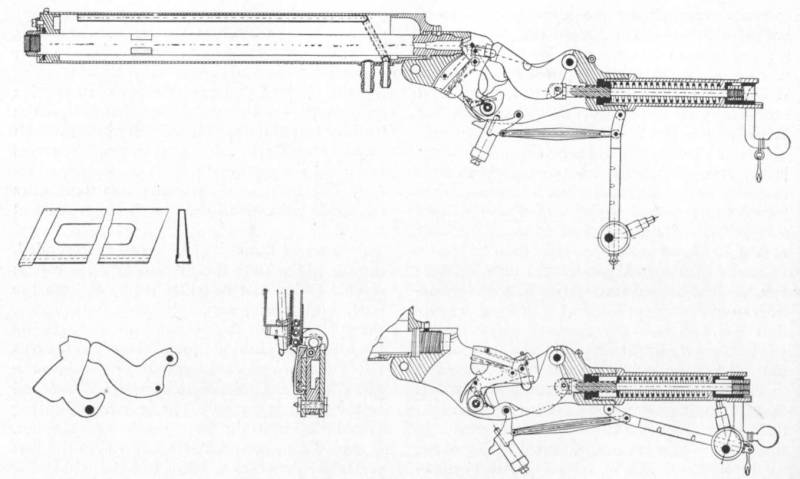
Another diagram of the machine gun "Salvator-Dormus". On the left is a pack device for cartridges. On the right - the work of the pendulum lever. You can clearly see the hole through which spent cartridges fell down from the bolt box
Beneath this lever was a rate-of-fire regulator pendulum with an adjustable weight that oscillated as the machine gun fired. The load moved along the bar and was fixed on it. The lower the load, the stronger the amplitude of swinging the lever, the more time it takes, and therefore the longer the reloading cycle lasts. The higher the load, the faster the pendulum moves back and forth and the more often the machine gun shoots. The adjustment range was from 180 to 300 rounds per minute.
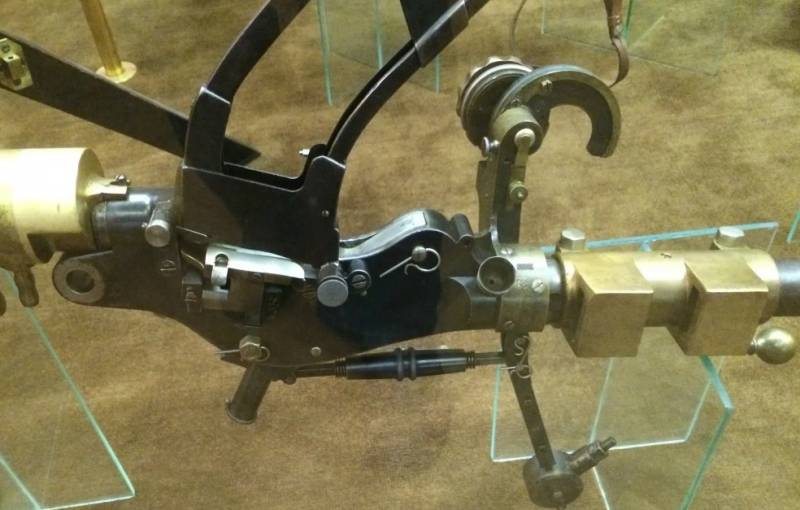
The bolt part of the machine gun "in all its glory." Pay attention to the noticeable recesses on the pendulum lever with the load, for its reliable fixation. Museum of Military History, Vienna. Photo forgottenweapons.com
That is, in fact, it was another “potato digger”, like the 1895 Browning machine gun of the year. Only his lever moved under the barrel, and the powder gases flowing from it threw it away. At the Salvator-Dormus, the lever swayed under its breech, which, of course, was not very convenient for the shooter. But on the other hand, the very possibility of adjusting the rate of fire really liked the Austro-Hungarian military, who, like the military of many other countries of that time, did not spare money for braids and ceremonial sewing on uniforms, but were very zealous about the consumption of cartridges when shooting!
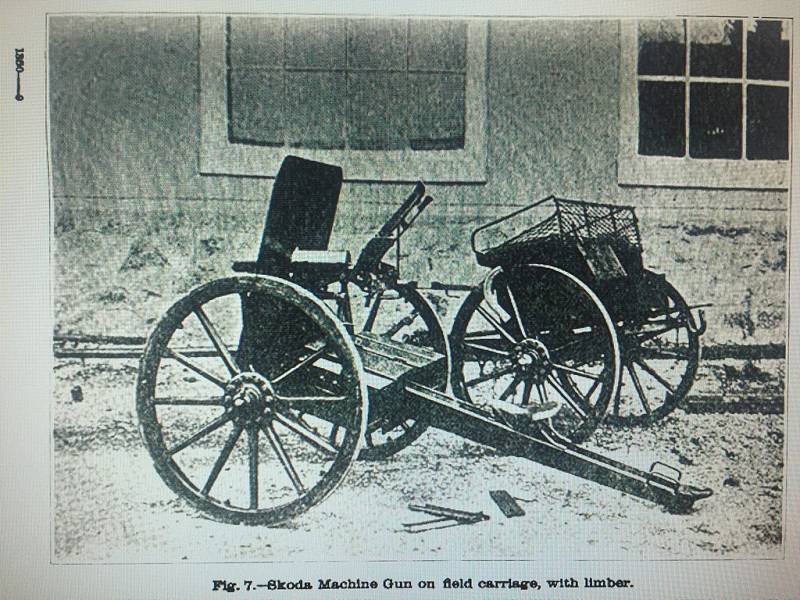
Since the amplitude of the pendulum lever was quite large, and it was quite long, not every machine was suitable for it. At the beginning, this one was used, wheeled, with a high shield, in the fashion of that time!
The M1893 was simpler and cheaper to manufacture than the Maxim machine gun. The weakest point of its design was the open gravity-fed magazine, which caused cartridge feed delays from time to time. In addition, in order for the sleeves to be easily extracted from it, the cartridges had to be lubricated. Therefore, next to the store, an oil dish was also strengthened on it. A spring-loaded rod passed through it. Each next cartridge, before falling into the barrel, pressed this rod and received a drop of oil! No oil - and the machine gun usually jammed. Of course, Maxim also needed oil, but Salvator-Dormus consumed it in very large quantities, and besides, dirt very easily stuck to oiled surfaces!
The first baptism of fire of a machine gun took place in 1900 during the Chinese Boxer Rebellion. Then the cruiser "Zenta" delivered these machine guns to China, and they helped to protect the embassy of Austria-Hungary in Beijing. The M1893 functioned well and remained in service with Austria-Hungary until 1918, but was gradually replaced by the more advanced Schwarzlose 1907/12 machine gun.
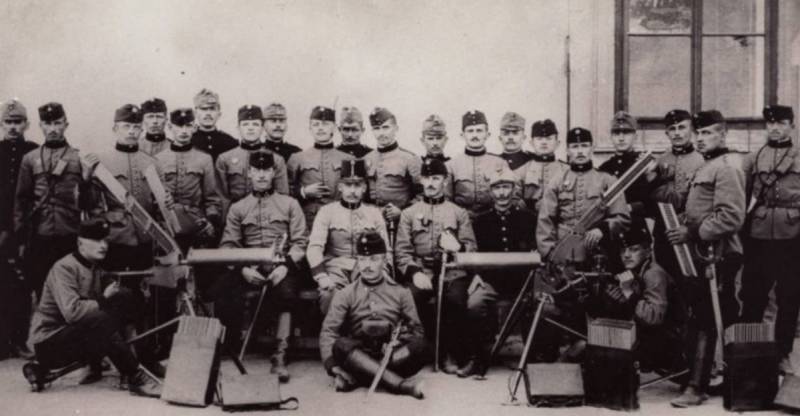
Soldiers of the Austro-Hungarian army with M1893 machine guns. Many have cartridge packs in their hands, which were used for faster loading of the magazine of this machine gun.
Skoda engineers periodically improved the M1893. So, to the very first sample with an air-cooled barrel, a 3-liter water-cooling tank was added. Moreover, if the Maxim and most of its analogues used just a cylinder with water with filling and draining, then the Salvator-Dormus machine gun had a system with a circulation pump and an additional tank. This made it possible to ensure a constant supply of fresh cold water to the barrel for cooling and not to create a treacherous cloud of steam during prolonged firing. The "gravity store" was replaced with a belt feed. The pendulum rate of fire control system has also been redesigned for a higher rate of fire and is now consistently firing at 300 rounds per minute.
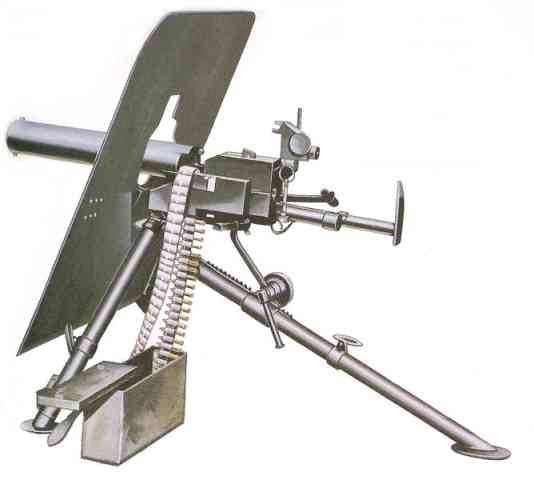
Skoda M1909
In 1909, Skoda engineers completely redesigned the M1902 so that it could compete with the Schwarzlose machine gun, which was adopted by the monarchy in 1905. In the M1909, an oiler was again added, which increased the rate of fire to 425 rounds per minute. The belt feed system used a 250-round fabric belt that entered the left side of the receiver and exited from the top. However, the tape system did not completely eliminate power problems. By the way, in the USA in 1894 this machine gun was also tested, they fired 600 rounds of ammunition, but they did not show much interest in it.

Information